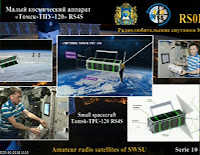Below is the full news release from ARISS:
ARISS News Release No. 18-12
Dave Jordan, AA4KN
ARISS PR
ARISS SSTV Joins with NASA On The Air for a Special Event
Oct. 19, 2018:
Amateur Radio OnThe International Space Station (ARISS) is
planning a very special Slow Scan TV event currently scheduled to start October
27 about 10 am UTC. Helping to support the event will be NASA’s Space,
Communication and Navigation (SCaN) Dept.
The Space Communications and Navigation (SCaN) program manages
NASA’s three most important communications networks. The Space Network (SN),
Near Earth Network (NEN), and the Deep Space Network (DSN.
Just as in past ARISS SSTV commemorations, 12 images will be
downlinked, but this time with 6 featuring the SCaN educational activities
while the other 6 images will commemorate major NASA anniversaries, ie
when NASA was established, astronauts first landing on the moon, etc.
In addition to the fun of receiving these images, participants can
qualify for a special endorsement for the NASA On The Air (NOTA) celebration
event. To learn more about NOTA, visit ( https://nasaontheair.wordpress.com).
Once received, Images can be posted
and viewed at http://www.spaceflightsoftware.com/ARISS_SSTV/index.php
.The transmissions are expected to be broadcast at the usual frequency of
145.800 MHz using the PD-120 SSTV mode.
Please note that the event is
dependent on other activities, schedules and crew responsibilities on the ISS
and are subject to change at any time.
More information will follow soon, so please continue to check for
news and the most current information on the AMSAT.org
and ARISS.org websites, the AMSAT-BB@amsat.org, the ARISS
facebook at Amateur Radio On The International Space Station (ARISS) and ARISS
twitter @ARISS_status.
About ARISS
Amateur Radio on the International Space Station (ARISS) is a
cooperative venture of international amateur radio societies and the space
agencies that support theInternational Space Station (ISS). In the United
States, sponsors are the Radio Amateur Satellite Corporation (AMSAT), the
American Radio Relay League (ARRL), the Center for the Advancement of Science
in space (CASIS) and National Aeronautics and Space Administration (NASA). The
primary goal of ARISS is to promote exploration of science, technology,
engineering, and mathematics (STEM) topics by organizing scheduled contacts via
amateur radio between crew members aboard the ISS and students in classrooms or
public forms. Before and during these radio contacts, students, educators,
parents, and communities learn about space, space technologies, and amateur
radio. For more information, see www.ariss.org.
Also join us on Facebook: Amateur Radio on the International
Space Station (ARISS)
Follow us on Twitter: ARISS_status
Media Contact:
Dave Jordan, AA4KN
ARISS PR
**Oct. 23 Update**Looks like the event will run continuously from Oct 27 starting around 10:00 UTC and ending Oct 29 around 19:30 UTC.
**Oct 25 Update**
Certificates for receiving images will be available. See details posted at https://ariss.pzk.org.pl/sstv/ for complete information.
**Oct 27 Update**
Seems the event started with a bit of confusion. Images were initially being down linked on the wrong frequency. Another complication is that the MMSSTV overlay was active and covering some of the images. Seems these are trying to be fixed so hopefully everyone can try to capture images as they were intended to be transmitted.














